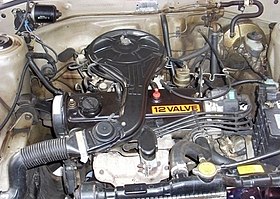Toyota E engine
| E series engine family | |
|---|---|

2E engine
|
|
| Overview | |
| Manufacturer | Toyota |
The Toyota E engine family is a straight-4 piston engine series, and uses timing belt rather than a chain. The E engines were the first multi-valve engines from Toyota designed with economy, practicality and everyday use in mind (rather than performance). Like many other Toyota engines from the era, the E engine series features a cast iron block, along with an aluminum cylinder head. E engines are lighter compared to earlier Toyota engines, due the hollow crankshaft, thinned casting of the cylinder block, and several other reductions in auxiliaries as well as in the engine itself. Carbureted versions include a newly designed, variable-venturi carburetor. All of these changes improved economy and emissions. The members of the E engine family, range from 1.0 L to 1.5 L. The E family supplanted the K engines in most applications. A large number of parts in the E engine series are interchangeable between each other.
The 1E is a 1.0 L (999 cc) carbureted 12 valve SOHC engine. Bore was 70.5 mm and stroke was 64.0 mm. Compression ratio was 9.0:1. It appeared in 1985. Output ranged at about 55 hp (41 kW) at 6,000 rpm, while torque is 75 lbf·ft (102 N·m) at 3,500 rpm.
The 2E is a 1.3 L SOHC version with three valves per cylinder. Output ranged from 65 hp (48 kW) to 82 hp (61 kW) at 6000 rpm with 72 lb·ft (98 N·m) of torque at 3600 rpm to 77 lb·ft (104 N·m) of torque at 5200 rpm. It appeared in 1985, and was discontinued after 1998. The 2E engines appeared in both carbureted and fuel-injected versions. The 2E-TE, appearing in 1986, was a turbocharged engine producing 101 hp (75 kW). A later version, the 2E-TELU produced 110 hp (82 kW). Some parts on the 1E and 2E engines are interchangeable, for example the gearboxes.
...
Wikipedia
